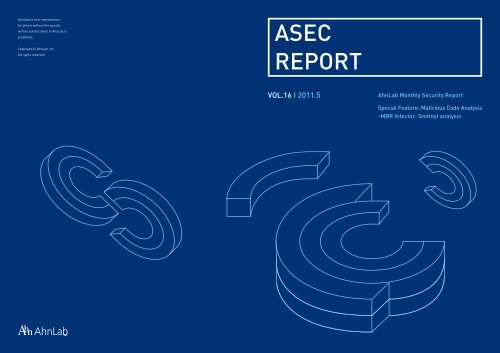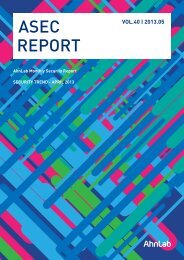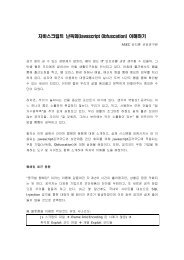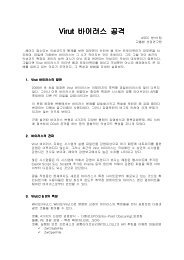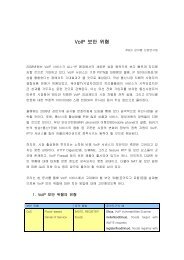You also want an ePaper? Increase the reach of your titles
YUMPU automatically turns print PDFs into web optimized ePapers that Google loves.
<strong>ASEC</strong> <strong>REPORT</strong>Vol.16Malicious Code TrendSecurity TrendWeb Security Trend5 601. Malicious Code Trenda. Malicious Code StatisticsTop 20 Malicious Code ReportsThe table below shows the percentage breakdown of the top 20 malicious codes reported in April2011. As of April 2011, Textimage/Autorun is the most reported malicious code, followed by Win-Trojan/Overtls27.Gen and JS/Redirect, respectively. 8 new malicious codes were reported this month.Top 20 Malicious Code Variant ReportsThe table below shows the percentage breakdown of the top 20 malicious code variants reportedthis month. As of April 2011, Win-Trojan/Onlinegamehack is the most reported malicious code,representing 16.7% (1,781,690 reports) of the top 20 reported malicious code variants, followed byWin-Trojan/Winsoft (1,385,102 reports) TextImage/Autorun (1,148,775 reports).Ranking ↑↓ Malicious Code Reports PercentageRanking ↑↓ Malicious Code Reports Percentage1 — Textimage/Autorun 1,148,610 26.2 %2 NEW Win-Trojan/Overtls27.Gen 540,652 12.3 %3 ▲1 JS/Redirect 471,011 10.7 %4 2 JS/Agent 429,722 9.8 %5 — Win32/Induc 224,589 5.1 %6 NEW Win-Trojan/Winsoft.46080.BR 188,926 4.3 %7 — Win32/Palevo1.worm.Gen 156,080 3.6 %8 NEW Win-Trojan/Winsoft.78981.CIB 126,814 2.9 %9 3 Win32/Conficker.worm.Gen 121,739 2.8 %10 3 Win32/Olala.worm 111,065 2.5 %11 2 Win32/Parite 102,528 2.3 %12 NEW Dropper/Malware.94432.B 94,972 2.2 %13 ▲6 Win32/Virut.f 93,421 2.1 %14 ▲4 VBS/Solow.Gen 87,282 2.0 %15 NEW Win32/Flystudio.worm.Gen 86,516 2.0 %16 ▲1 JS/Exploit 85,943 2.0 %17 ▲3 VBS/Autorun 82,326 1.9 %18 NEW Win32/Virut 80,306 1.8 %19 NEW Win-Trojan/Winsoft.46080.AR 76,276 1.7 %20 NEW Win-Trojan/Fosniw.75776 73,389 1.7 %4,382,167 100 %[Table 1-1] Top 20 Malicious Code Reports1 — Win-Trojan/Onlinegamehack 1,781,690 16.7 %2 ▲5 Win-Trojan/Winsoft 1,385,102 13.0 %3 ▲1 Textimage/Autorun 1,148,775 10.8 %4 2 Win-Trojan/Downloader 825,243 7.7 %5 2 Win-Trojan/Agent 770,719 7.2 %6 NEW Win-Trojan/Overtls27 540,652 5.1 %7 ▲6 JS/Redirect 471,011 4.4 %8 ▲11 Dropper/Malware 470,453 4.4 %9 1 JS/Agent 429,723 4.0 %10 — Win32/Conficker 410,871 3.9 %11 2 Win32/Autorun.worm 408,925 3.8 %12 — Win32/Virut 302,494 2.8 %13 8 Win-Trojan/Adload 272,959 2.6 %14 0 Win32/Kido 260,927 2.4 %15 9 Win-Adware/Koradware 260,233 2.4 %16 — Win32/Induc 224,724 2.1 %17 ▲1 Dropper/Onlinegamehack 184,186 1.7 %18 NEW VBS/Solow 183,263 1.7 %19 NEW Win32/Palevo 178,027 1.7 %20 NEW Win32/Palevo1 156,080 1.5 %10,666,057 100 %[Table 1-2] Top 20 Malicious Code Variant Reports
<strong>ASEC</strong> <strong>REPORT</strong>Vol.16Malicious Code TrendSecurity TrendWeb Security Trend910Top 20 New Malicious Code ReportsThe table below shows the percentage breakdown of the top 20 new malicious codes reported inApril 2011. As of April 2011, Win-Trojan/Overtls27.Gen is the most reported new malicious code,representing 33.4% (540,652 reports) of the top 20 reported new malicious codes, followed by Win-Trojan/Winsoft.46080.BR (188,926 reports).01. Malicious Code Trendb. Malicious Code IssuesRanking Malicious Code Reports Percentage1 Win-Trojan/Overtls27.Gen 540,652 33.4 %2 Win-Trojan/Winsoft.46080.BR 188,926 11.7 %3 Win-Trojan/Winsoft.78981.CIB 126,814 7.8 %4 Dropper/Malware.94432.B 94,972 5.9 %5 Win-Trojan/Fosniw.75776 73,389 4.5 %6 Win-Trojan/Bho.213216 69,742 4.3 %7 Win-Trojan/Winsoft.78085.B 67,985 4.2 %8 Win-Trojan/Winsoft.75776.D 54,382 3.4 %9 JS/Ms10-018 44,125 2.7 %10 Win-Trojan/Winsoft.78089 38,098 2.4 %11 Win-Spyware/BHO.233984 37,581 2.3 %12 Win-Trojan/Downloader.75776.X 36,114 2.2 %13 Dropper/Malware.235520.CF 34,064 2.1 %14 Win-Adware/ColorSoft.490530 33,413 2.1 %15 Win-Trojan/Winsoft.78125 33,004 2.0 %16 Win-Trojan/Winsoft.78109 32,339 2.0 %17 Win-Trojan/Onlinegamehack.115200.Y 30,069 1.9 %18 Win-Adware/KorAdware.98304.F 30,014 1.9 %19 Win-Trojan/Onlinegamehack.122880.AM 27,887 1.7 %20 HTLM/Downloader 26,723 1.6 %1,620,293 100 %[Table 1-3] Top 20 New Malicious Code ReportsNew imm32.dll patching techniqueOn March 2, <strong>ASEC</strong> found a malware that steals online gameaccounts works in different ways according to whether V3 isrunning or not. Attackers are applying new malicious techniques tomalware, as the one above, to patch imm32.dll. Similar maliciouscodes that were reported between the end of February and earlyMarch forward all the Export functions of the imm32.dll file asshown in Fig 1-5.[Fig. 1-5] Previous patching techniquesBut, the latest malicious codes do not forward the Exportfunctions as shown in Fig 1-6.[Fig. 1-6] Latest patching techniquesWe analyzed the malicious code that actually patches the imm32.dll file and found it pushes and calls all the export functions.The code that calls the function is designed to load the imm32A.dll as a sub routine.[Fig. 1-8] Malicious code that loads imm32A.dll as sub routine[Fig. 1-7] Malicious codes designed to infect the systemInstead of directly forwarding the export functions, the latestmalware calls the functions with separate codes. V3 detects thisTrojan horse as:- Win-Trojan/PatchedImm.Gen- Win-Trojan/PatchedImm2.Gen
<strong>ASEC</strong> <strong>REPORT</strong>Vol.16Malicious Code TrendSecurity TrendWeb Security Trend11 12[Fig. 1-8] Malicious code that loads imm32A.dll as sub routine[Fig. 1-10] Fake scan results- Win-Trojan/Fakeav.1243656- Win-Trojan/Fakeav.1242632If the malicious file infects your system, it will execute thesvchost.exe file in the infected system and insert its codes intoMore similar threats are expected in the future. You mustalways purchase software from their official sites, and downloadthe memory sector to execute itself.[Fig. 1-13] Malicious codes inserted into memory sectorfreeware from trusted sites. You must also scan the file todownload with an updated antivirus before downloading it.Rogue antivirus disguised as UPS notificationA malware variant found in March 24 disguised as a notificationfrom UPS (United Parcel Service) is still propagating. Twodifferent notifications are still being distributed.Using “non-typical” function name to patch imm32.dll Like other rogue antiviruses, once installed, the rogueBitDefender automatically scans the entire system and triggers[Table 1-4] One of the two notifications[Fig. 1-9] Trojan horse that changes the function namefake alerts claiming your PC has security issues and infectionsSubject United Parcel Service notification that need to be removed.Dear customer.The parcel was sent your home address.[Fig. 1-11] Fake scan result with scare message that the computer is infectedAnd it will arrive within 3 business day.Message More information and the tracking number areattached in document below.vThank you.? 1994-2011 United Parcel Service of America, Inc.The malicious codes will then use the system file to downloadand run a malicious file from a system in Ukraine. Thedownloaded file will run ‘XP Home Security”, a rogue antivirus.[Fig. 1-14] XP Home Security recognized by Windows Action Center- UPS.zip- UPS-tracking.zipAlong with the Trojan horse discussed above, <strong>ASEC</strong> discoveredanother Trojan horse that changes parts of the export function.Malicious codes that bypass detection by antivirus programs willAttachmentsDecompressing the attached UPS.zip file willcreate UPS.exe (18,944 bytes).Decompressing the attached UPS-tracking.zip filewill create UPS-tracking.exe (18,432 bytes).continue to evolve. Recently, we also found malicious codes thatpatch the Windows system files such as ksuser.dll, midimap.dll andcomres.dll. It is extremely important to regularly update your OS,web browser and Adobe products to the latest version to preventsuch attacks.V3 detects this Trojan horse as:If you open the web browser installed on an infected system, anotification will be displayed informing you that your web pagerequest has been denied.[Fig. 1-12] Web page request canceled by rogue BitDefender[Table 1-5] One of the two notifications- UPS Package- UPS: Your PackageSubject- Your Tracking Number- United Postal Service Tracking Nr.The rogue antivirus will scan your system and alert you with fakeor simulated detection of malware.[Fig. 1-15] Fake scan results- Win-Trojan/PatchedImm.GenDistribution of fake BitDefender AVOn January 31, <strong>ASEC</strong> reported a rogue antivirus disguised asAVG Anti-Virus 2011, a legitimate free antivirus provided by AVG.MessageGood day,We were not able to deliver parcel you sent on the19nd March in timebecause the recipient’s address is not correct.Please print out the invoice copy attached andcollect the package at our office.Recently, a rogue antivirus disguised as BitDefender developed- UPS_TRACKING_NR_.zipby the Rumanian security solution provider, Softwin, wasreported. The user interface of the rogue antivirus looks exactlylike that of BitDefender – even the menus and logo.V3 detects this Trojan horse as:AttachmentsDecompressing the attached UPS_TRACKING_NR_.zip file will create UPS_TRACKING_NR____.DOC.exe(546,304 bytes).
<strong>ASEC</strong> <strong>REPORT</strong>Vol.16Malicious Code TrendSecurity TrendWeb Security Trend13 14Like other rogue antiviruses, it tricks you into registering for theservice to remove the threats.[Fig. 1-16] Scare message that the system is infectedFacebook image spamFacebook spam has been continuously reported from thebeginning of this year. The latest spam, image spam is anYou are advised to exercise caution when opening any emailattachment, as there exist other variants. V3 detects this Trojanas:[Fig. 1-20] Ransomware that demands activation of license via phone callobfuscating method in which the text of the message is stored asa GIF or JPEG image and displayed in the email. Image spamsexisted from last year.- Image spam on June 2010- Image spam from Fedex on August 2010- Image spam from USPS on October 2010- Image spam from DHL and UPS on October 2010The Facebook image spam reportted this month was sent underthe subject of "Spam from your Facebook account" or "Spamfrom your account".- Win-Trojan/Bredo.27136- Win-Trojan/Agent.30808- Win-Trojan/Bredolab.26624.AY- Win-Trojan/Oficla.108032Fake Windows license ransomware found in KoreaOn March 22, we discovered a ransomware disguised as a fakealert. The ransomware is a copy of the license for the WindowsOS installed on the system. It tricks the victim into calling aphone number to get a new license. It seems to be a new variantof the Korean cyber crime ransomware that was reported onThe alert tricks you into registering to use the rogue antivirusservice to remove the threat from your system.[Fig. 1-17] Fake page to trick you into paying for service[Fig. 1-18] Facebook image spamMarch 3.When executed, it gets the language code of the infected systemand when the system is a Korean system, it displays a fakealert stating the system will be locked until it is activated witha proper license because the system’s license is a copy. It willBut, the phone numbers are non-existent. This ransomware isdistributed via vulnerable websites. Be careful when accessinguntrusted websites and always update your web browser to thelatest version to prevent such attacks.V3 detects this Trojan as:also prevent other programs on the system and the system itselffrom running properly.- Win-Trojan/Fakeav.320000.AT- Win-Trojan/Serubsit.145920[Fig. 1-19] Ransomware showing fake Windows license alertMalware disguised as map hack for StarcraftThe following spam was also detected.Malware disguised as map hack for Starcraft is on the rise again.This malware is not new – it has existed for some time. Map hack[Table 1-6] Facebook image spam’s subject, message and attachmentis a generic term that refers to a method or third-party programHowever, unlike other rogue antiviruses, this rogue antivirus isSubjectYour password is changedDear Customerthat enables a gamer to see more of a level than intended by thedeveloper. It can be found easily online.recognized by Windows Action Center, so victims can get easilytricked.Spam is sent from your FaceBook account.Your password has been changed for safety.[Fig. 1-21] Map hack for Starcraft searched on search engineV3 detects this rogue antivirus as:- Win-Trojan/Chepvil.18432- Win-Trojan/Chepvil.18944.B- Win-Trojan/Fakeav.143872.H- Win-Trojan/Fakeav.143872.I- Win-Trojan/Fakeav.64008- Win-Trojan/Fakealert.546304- Win-Trojan/Agent.33928.B- Win-Trojan/Agent.33928.CMessageAttachmentInformation regarding your account and a newpassword is attached to the letter.Read this information thoroughly and change thepassword to complicated one.Please do not reply to this email, it's automaticmail notification!Thank you for your attention.Your Facebook!- FacebookP[-digit number].zip (23,586 bytes)Decompressing the attached file will create‘FacebookPassword.exe (26,624 bytes)’.The file downloads malware from an externalsystem and infect systems with rogue antivirus.If you fall victim to this false alert and click Next, you will beadvised to call the following phone numbers to activate yourlicense.Some map hacks that are provided on blogs or forums installmalware (aaa.exe) along with the map hack program.
<strong>ASEC</strong> <strong>REPORT</strong>Vol.16Malicious Code TrendSecurity TrendWeb Security Trend15 16[Fig. 1-22] Map hack installation process[Fig. 1-25] Malware disguised as V3 Lite fileAs you can see above, when the dropper (aaa.exe) runs, a maliciousDLL gets created on the system folder. The DLL then gets injectedinto the svchost.exe file and runs, and attempts to access amalicious site.[Fig. 1-23] Access attempts by DLLIf you are suspicious about any files on your system, report it to asecurity company and always update your antivirus and Windowssecurity to the latest version.iPhone and iPad keyloggerWhen we tested the malware, there were access attempts but noother actions (such as file download). The URL for the website waslocated in Hong Kong.[Fig. 1-24] Network information of web siteThere is a keylogger that logs keystrokes on iPhone and iPad.It runs on iOS, but not on all iPhones or iPads. It can only getinstalled if the device has been jailbroken. It logs keystrokes andsends them to an email address.[Fig. 1-26] Site selling keylogger for iOSUsing map hack to easily win in games may infect your systemwith malware. You must be extra careful when downloading suchtools.Distribution of malware in the name of well knownprogramsRecently, there have been malware reported to be distributedin the name of well known products, people and companiesand social issues to win trust of victims. The following malwareis named v3lite.exe to trick victims into believing they aredownloading V3 Lite program.A similar case where a malware only runs on jailbrokeniPhones and iPads was reported before on November 2009.You are advised not to jailbreak your iPhone or iPad to preventunexpected security threats.
<strong>ASEC</strong> <strong>REPORT</strong>Vol.16Malicious Code TrendSecurity TrendWeb Security Trend17 1801. Malicious Code Trendc. Special Feature: Malicious Code AnalysisMBR Infector : Smitnyl analysisThe Master Boot Record (MBR) is the first sector of a hard disk. It stores information about installedoperating systems. This small section exists outside the storage of a disk's partitions. It tells themachine how to boot an operating system and where individual partitions are stored. It contains atable of partitions and a code for the program used by the BIOS to boot the system. MBR is not asinfected as much as the PE (Portable Executable) file: it is that much more complicated and sizerestrictive,and a tiny error or bug may cause the computer not to boot the operating system.Recently, a new bootkit, Smitnyl Bootkit, was discovered – it is propagating via free file sharingnetwork.[Fig. 1-29] Process of main dropper1. Infection and signs of attackSmitnyl Bootkit saves infection data in the MBR and sectors. It also infects the userinit.exe file whenthe system restarts to download a malicious file from a designated website. The changes in MBRbefore and after being infected can be found in the images below:[Fig. 1-27] Original MBR[Fig. 1-28] Infected MBRWhen the data saved in the resource sectors gets loaded, the MBR, sectors and userinit.exe file willget infected. The process is as below:1. Saves orginal MBR to the 5th sector.2. Loads the userinit.exe infector payload to the resource sector (Name=’71’) and saves to 39thsector3. Loads encoding data to resource sector (Name=’72’) and saves to 45th sector4. Loads encoding data to resource sector (Name=’6E’) and saves to 46th sector-> When XOR calculation is done with 0x7F, the data saved to the 45th and 46th sectors createan executable file that acts as a downloader5. Reads 0x200 (512 bytes) of data from resource sector (Name=’70’) and overwrites MBR6. Reads data (MBR file system infector routine) after 0x200 (512 bytes) of data from resourcesector (Name=’70’) and saves it to 32nd sectorThe data saved to each sector are used to create downloader or infect userinit.exe during systemThe process of the main dropper (Dropper/Smitnyl.37076) can be found in the image below. Thepayloads to infect MBR, each sector and the userinit.exe file are saved to each resource sector, andthe downloader is also divided and saved in two resource sectors.boot. The userinit.exe file is infected by infecting MBR to bypass detection by antivirus and WFP(Windows File Protection).
<strong>ASEC</strong> <strong>REPORT</strong>Vol.16Malicious Code TrendSecurity TrendWeb Security Trend19 202. Function of each moduleB. Backup of normal MBR2.1 Dropper (Dropper/Smitnyl.37076)The main functions of the dropper, Dropper/Smitnyl.37076, are as below. It first checks whetherthe Chinese hard disk monitoring tools, HDDGMON.exe and DF5Serv.exe, are running. If they are, itsearches for and loads ‘Name=6F’ to the resource saves it under the name of pcidump.sys, beep.sysor DeviceCutter.sys. Then it starts the service of each file.To infect MBR, the original MBR is backed up in the 5th sector. This is done by reading the MBR andsaving it to the stack.[Fig. 1-32] Saving 512-byte MBR to stack[Fig. 1-30] Functions of dropperSetFilePointer API is used to move the file pointer to the 5th sector and overwrite MBR in the (0xA00 =2560, 2560/512 = 5th sector) stack.[Fig. 1-33] Backing up original MBR in 5th sectorAfter that it loads the data in the resources to infect the MBR and userinit.exe file, and save it to thedesignated sectors. It then deletes itself, the dropper, and completes its task.A. Bypass Windows File ProtectionSFC.dll file is a system file checker saved to the %SYSTEM% folder. To create a file in the folder, thedropper uses the SFC.dll file’s 5th function, sfcFileException, to bypass Windows File Protection.[Fig. 1-31] SFC.dll _ sfcFileException function used to bypass Windows File ProtectionC.Load data to resource sectorsAs mentioned before, the main function of the dropper is to load and save data to resource sectorsand create file. The methods to load data are mostly similar. We will look into the method of saving0x71 resource to the 39th sector. It uses FileResourceA API and looks for the data (Size=0xA00,Address=0x00407050) that falls under the ‘Type = ‘RES’ and Name = ‘71’ to load. Then it usesSetFilePointer API to move the file pointer to the 39th sector and saves as much data as 0xA00 in0x00407050 loaded to (0x4E00 = 19968, 19968/512 = 39th sector). As WriteFile API is used to write 512bytes (0x200) each time, it repeats 5 time to finish writing 0xA00.
<strong>ASEC</strong> <strong>REPORT</strong>Vol.16Malicious Code TrendSecurity TrendWeb Security Trend21 22[Fig. 1-34] Saving Type = ‘RES’, Name = ‘71’ resource data to 39th sectorE. Self-deletion by main dropperIt runs ‘cmd /c del %Main Dropper%\MainDropper.exe > nul’ command to delete itself.[Fig. 1-36] Self-deletion routineD. Infected MBRIt uses FileResourceA API to search for and load data (Size=0xF2A, Address=0x00406120) fallingunder Type = ‘RES’ and Name = ‘70’ in the resource sector of the file, and overwrites the MBR sectorwith the first 512 bytes of data.[Fig. 1-35] Overwriting data in MBR sector2.2 Infected ‘userinit.exe’ (Win-Trojan/Agent.25600.YE)The data saved to the main dropper’s resource sector under the name of 71 is written in the 39thsector and overwrites userinit.exe when the system restarts. It decodes and executes the encodeddata saved to the 45th sector. If 360Safe exists, it terminates 360safe IE Protection and creates a fakeexplorer.exe in the Temporary folder (%Temp%) to write the decoded data in the 45th sector. It alsoruns the real explorer.exe to trick the victim into thinking explorer.exe is running properly.[Fig. 1-37] userinit.exe infection codes saved to 39th sector
<strong>ASEC</strong> <strong>REPORT</strong>Vol.16Malicious Code TrendSecurity TrendWeb Security Trend23 24A. Termination of 360Safe IE ProtectionRegOpenKeyExA API is used to check whether HKEY_LOCAL_MACHINE\SOFTWARE\360Safe\safemon registry exists. If it does, ‘IEProtAccess’ and ‘IEProtNotify’ are set to ‘0’ to terminate360Safe IE Protection. 360Safe IE Protection is a Chinese antivirus.the stack and conduct XOR calculation with 7F. It corrects the MZ and PE signatures as ‘4D5A’ and‘5045’ and writes in the fake explorer.exe. It is set to repeat these steps nine times.explorer.exe[Fig. 1-39] Decoding routine and file change[Fig. 1-38] Termination of 360Safe IE ProtectionB. Creation and execution of explorer.exeTo save fake explorer.exe, it retrieves the Temporary folder location and then accesses the 45thsector and decodes encoded data and creates and runs the fake explorer.exe in the Temporaryfolder. It also executes the real explorer.exe to trick the victim into thinking explorer.exe is runningproperly. During the decoding process, it reads 512 bytes of data in the 45th sector and saves it to[Fig. 1-38] Termination of 360Safe IE Protection2.3 Fake explorer.exe (Win-Trojan/Pincav.4608.AT)The encoded data saved under the name of 72 and 6E in the main dropper’s resource sector is writtenin the 45th and 46th sectors. The encoded data gets decoded by the saved routine in the 39th sectorand creates and runs fake explorer.exe. As shown below, it gets injected into iexplorer.exe to performdownload.[Fig. 1-40] Fake explorer.exe’s process
<strong>ASEC</strong> <strong>REPORT</strong>Vol.16Malicious Code TrendSecurity TrendWeb Security Trend25 26A. Execution of IEXPLORE.EXE with Hidden attribute and self-injectionIt retrieves ‘c:\program files\Internet Explorer\IEXPLORE.EXE’ path first and uses WinExec API torun iexplorer.exe with ‘Hidden’ attribute, and gets virtual memory space for the iexplorer.exe run byVirtualAllocEx API to inject itself through WriteProcessMemory API.[Fig. 1-41] IEXPLORE.EXE execution and injectionThe code routine of infected MBR shows that the malicious code creator does not only understand theMBR structure, but also the FAT and NTFS file system structure to use boot record values, MFT (MasterFile Table) header and attributes to get the required data. The data obtained is used to ultimately getinformation on userinit.exe and read the payload saved to the 39th sector to overwrite userinit.exe.A simple way to tell whether the userinit.exe file is infected or not is to check the file information.Information such as the file version will be displayed if the file is uninfected, and not if the file is infected.If you check the raw data with a Hex view tool, you will see 55 AA signature in the 0x28 openset. Thissignature is used to check whether the malicious code has infected the file.[Fig. 1-45] “Uninfected” userinit.exe and infected userinit.exeB. File download and executionIt runs the injected codes with ‘CreateRemoteThread’ and downloads http://sb.perfectexe.com/cs.gif and saves it as ‘C:\2008.exe’ and executes it.[Fig. 1-42] File download and execution3. Process of infected MBRThe main process of “uninfected” MBR is to find the partition to boot from the partition table andcall the boot sector of the partition. MBR in an infected system gets BOOT.INI file and WINDOWSand SYSTEM32 directory information to infect userinit.exe, and reads data to infect in the 39thsector to infect userinit.exe.A. Infection of userinit.exe[Fig. 1-46] userinit.exe infection routine in infected MBR[Fig. 1-44] Operation of infected MBR[Fig. 1-43] Normal operation of MBR
<strong>ASEC</strong> <strong>REPORT</strong>Vol.16Malicious Code TrendSecurity TrendWeb Security Trend2728The final process of infected MBR is to get the starting point and number of the sector to check and readthe file and then use ‘Extended Write Function (AH = 43h)’ and read the data saved to the 39th sector inthe memory’s ‘0x8C00’ sector. It compares the 0xAA55 signature to check whether the data has beenproperly read.4. WorkaroundAs a result of testing the malicious code with V3 IS 7.0, before the system is infected malware getsdetected and removed, but once the system is infected, infected MBR cannot get detected nor repaired.Infected userinit.exe gets detected as Win-Trojan/Agent.25600.YE, but does not get repaired because itis Windows system file, and is monitored by WFP (Windows File Protection). In other words, maliciousfiles that need to be removed get protected. There was a boot virus detection and repair function inV3, but ever since the Defo virus issue on March 2010, the function was removed from the engine. Asa makeshift, we are providing an exclusive solution for only our customers whose systems have beeninfected. This solution compares the partition table of the backed up MBR and infected MBR, and if it isthe same, it overwrites the backed up MBR.5. Conclusion‘Smitnyl Bootkit’ infects MBR: this could cause serious issues, as it is quite tricky to detect and repairinfected MBR. There have not been that many cases reported in Korea, but many victims of this attackmight not even know their system is infected. With this, this malware appeals to many attackers. If thismalware propagates, it will cause a big stir amongst security companies. Smitnyl Bootkit contains aChinese hardware monitoring tool and prevents 360Safe, a Chinese antivirus, from running properly.This indicates that the bootkit has been created by Chinese hackers. With this, Chinese online hackingsites and forums should be monitored to get information for researches on the method or othermethods to detect and repair boot viruses.
<strong>ASEC</strong> <strong>REPORT</strong>Vol.16Malicious Code TrendSecurity TrendWeb Security Trend31 32Malicious Code TrendSecurity TrendWeb Security TrendAPT attacks RSARSA, the security division of EMC suffered a security breach byAPT on March 18. RSA issued an ‘Open Letter to RSA Customers’on its website and pleaded with their clients to take extra cautionwhen using their product. APT is a security threat – it was usedin Operation Aurora attack to hack Google on January 2010,Stuxnet to attack an Iranian nuclear power plant on July 2010,and Night Dragon attack launched on a global energy companyon February 2011. On April 1, RSA published “Anatomy of anAttack” on its website to describe the attack method in detail.[Fig. 2-4] RSA attack anatomy (Source: EMC/RSA)1) Spam with the subject “2011 Recruitment Plan” was sent toemployees over two days – the personal information of targetedemployees was obtained from social network service.2) 2011 Recruitment plan.xls was attached to the spam – itcontained a SWF that exploits the zero-day vulnerability inAdobe Flash Player announced on March 15.3) The vulnerability is exploited to access user’s machineremotely with Poison Ivy (Trojan horse).4) The infected system is used to access the internal networkand get escalated privileges (administrator’s privileges) to thesystem.5) The data of the targeted system is copied to another systemand then compressed and encrypted.The three main steps of this ATP are as follows: gatherinformation of targets via social networking service, infecttarget’s system with social engineering method and exploitzero-day vulnerability of widely used software. Corporate ITdepartments must regularly train the staffs and executivesabout social engineering techniques so that they will pay moreattention to signs of irregularity in the internal network andsystem.7.7 million account information exfiltrated from SonyPlayStation networkData was exfiltrated from Sony PlayStation network that holdsnumerous game account information from all over the world.420,000 personal information was also exfiltrated from a Koreanfinancial institute, Hyundai Capital, just recently. The numberis incomparable with the number of account information thatwas stolen from Sony PlayStation network – 7.7 million. Unlikeother data exfiltration where the name, address, email address,date of birth, user ID, password and login information are stolen,more information was exfiltrated in this attack. With this, Sonyremoved the network and gamers were not able to downloadgames from the network and play games over the Internet.According to Sony, their network was attack between April 17and 19, but did not disclose the exact amount of information thatwas stolen. There is no evidence that credit card information has.been stolen, but there is a possibility. The exfiltrated informationcould be used maliciously. About 230,000 Korean users wereaffected, so you are advised to change your password. BecauseSony disclosed this attack one week after, there is a possibilityof secondary attacks launched against some users. In the past,secondary attacks meant sending off spam mail. For instance,ever since a user’s account information was stolen from Play.com, the user started receiving spam. The stolen informationcould be used for other malicious means. This method ofattack could be launched on other networks, so companies areadvised to reinforce their method in protecting their customer’sinformation safely.03. Web Security Trenda. Web Security StatisticsWeb Security SummaryAs of April 2011, there were 107,713 reported malicious codes, 704 types of reported malicious code,720 reported domains with malicious code, and 2,605 reported URLs with malicious code. The type ofreported malicious codes and domains and URLs with malicious code decreased, but the number ofreported malicious codes increased from last month.Category[Table 3-1] Website Security SummaryMonthly Blocked Malicious URLsAs of April 2011, the number of reported malicious codes increased 9% from 99,034 the previousmonth to 107,713.10,0005,00061,81799,034107,713ReportsBlocked malicious URLs 107,713Reported types of malicious code 704Domains with malicious code 720URLs with malicious code 2,6056) The compressed and encrypted data gets encrypted andcompressed again as RAR and exfiltrated to a hacked thirdparty system via FTP.02011.022011.03 2011.04[Fig. 3-1] ] Monthly Blocked Malicious URLs
<strong>ASEC</strong> <strong>REPORT</strong>Vol.16Malicious Code TrendSecurity TrendWeb Security Trend33 34Monthly Reported Types of Malicious CodeAs of April 2011, the number of reported types of malicious code decreased 7% from 759 the previousmonth to 704.1,00077475970475050025002011.02 2011.03 2011.04[Fig. 3-2] Monthly Reported Types of Malicious CodeMonthly Domains with Malicious CodeAs of April 2011, the number of reported domains with malicious code decreased 9% from 780 theprevious month to 720.Top Distributed Types of Malicious CodeAs of April 2011, adware is the most distributed type of malicious code representing 13.3% (14,371reports) of the top distributed type of malicious codes, followed by Trojan that represent 7.1% (7,602reports).Type Reports PercentageADWARE 14,371 13.3 %TROJAN 7,602 7.1 %DROPPER 2,668 2.5 %DOWNLOADER 1,727 1.6 %JOKE 1,024 1.0 %Win32/VIRUT 570 0.5 %APPCARE 199 0.2 %SPYWARE 62 0.1 %ETC 79,490 73.8 %Total 107,713 100 %[Table 3-2] Top Distributed Types of Malicious Code75,00079,49010,007747897205,0014,3717,6021,727 5702,668199 621,024AdwareTrojanDropperSpywareJokeETCDownloaderWin32/VIRUSAppcare02011.02 2011.03 2011.04[Fig. 3-3] Monthly Domains with Malicious CodeMonthly URLs with Malicious CodeAs of April 2011, the number of reported URLs with malicious code decreased 39% from 4,259 theprevious month to 2,605.[Fig. 3-5] Top Distributed Types of Malicious CodeTop 10 Distributed Malicious CodesAs of April 2010, Win32/Induc is the most distributed malicious code, with 51,683 cases reported. 3new malicious codes, including Virus/Win32.Induc, emerged in the top 10 list this month.Ranking ↑↓ Malicious Code Reports Percentage5,0002,5003,36702011.02[Fig. 3-4] Monthly URLs with Malicious Code4,2592,6052011.03 2011.041 ▲2 Win32/Induc 51,683 58.1 %2 NEW Virus/Win32.Induc 23,612 26.6 %3 ▲2 Win-Adware/Shortcut.InlivePlayerActiveX.234 3,355 3.8 %4 ▲2 Win-Adware/Shortcut.Unni82.3739648 2,249 2.5 %5 ▲5 Win-Adware/Shortcut.Bestcode.0002 1,537 1.7 %6 2 Win-Adware/ToolBar.Cashon.308224 1,455 1.6 %7 NEW Win-Trojan/StartPage.40960.AH 1,449 1.6 %8 — Win-Adware/Shortcut.Tickethom.36864 1,319 1.5 %9 2 Adware/Win32.ToolBar 1,224 1.4 %10 NEW Win-Joke/Stressreducer.1286147 1,010 1.1 %[Table 3-3] Top 10 Distributed Malicious Codes


